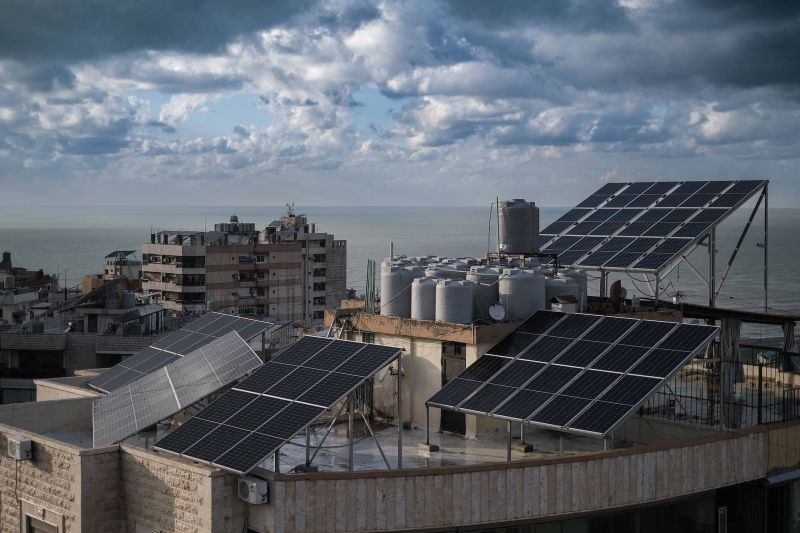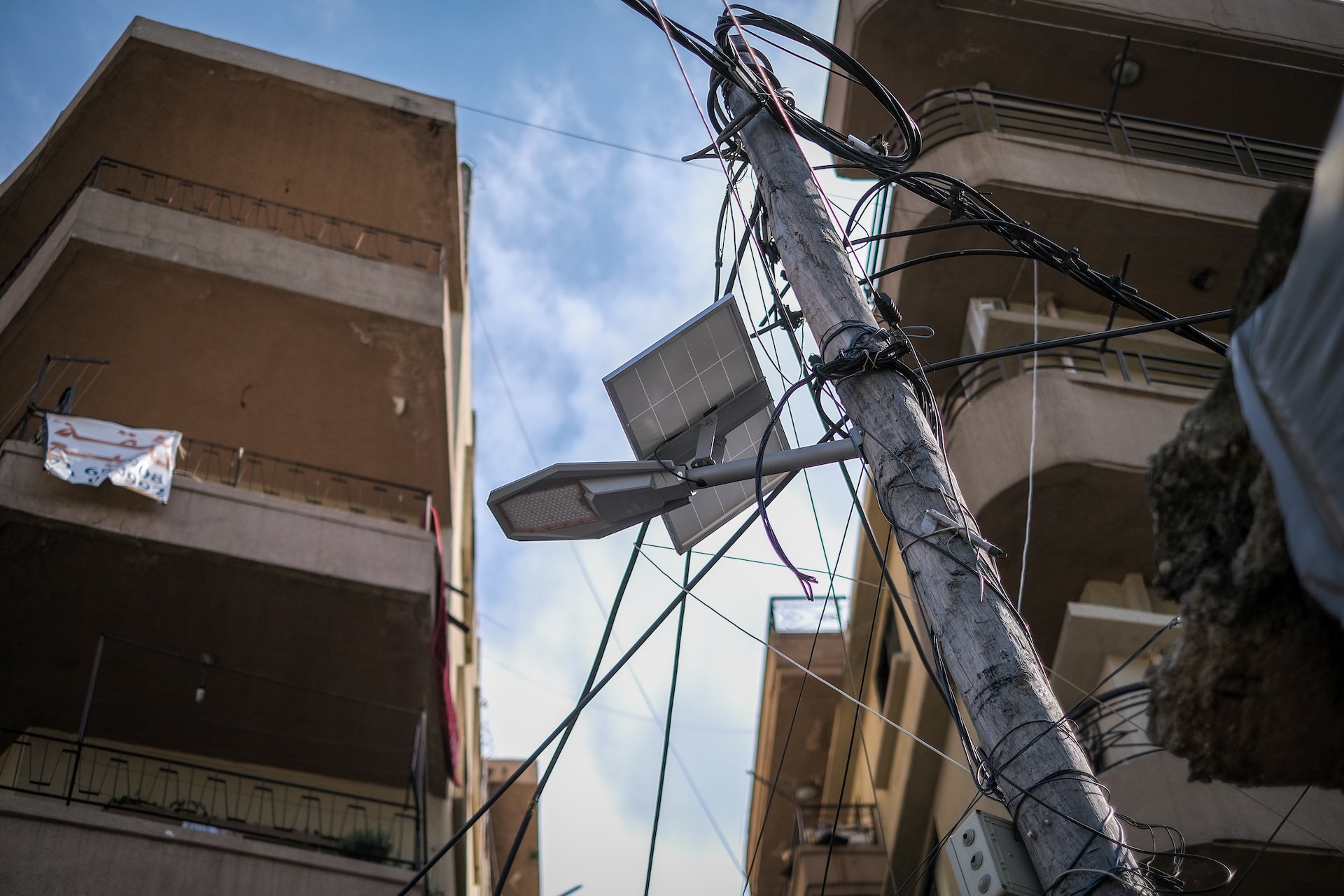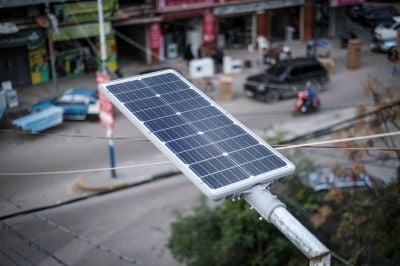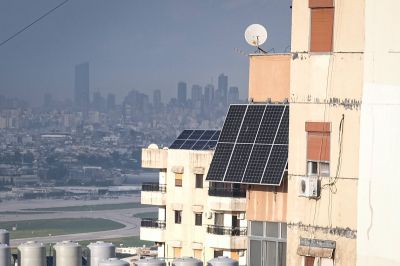
Solar panels set up on rooftops overlooking Beirut International Airport in Aramoun, south of Beirut, Jan. 14, 2024. (Credit: João Sousa/L'Orient Today)
BEIRUT — In the wake of Lebanon's energy crisis, there was a surge in people buying and installing solar power systems. Faced with chronic shortages from the public supplier Electricité du Liban (EDL), rampant private diesel generator rationing, and high fuel prices and electric bills, Lebanese citizens turned to solar as a flicker of hope amid the darkness.
Surveying the cityscape from above today, a mosaic of solar panels crown rooftops, soaking up the Mediterranean sun.
Largely from rooftop solar systems on private homes and businesses, the installed capacity of solar energy in Lebanon increased thirteenfold from 100 megawatts to 1,300 megawatts between 2020 and 2023, says Pierre Khoury, president of the government’s Lebanese Center for Energy Conservation (LCEC).
“We estimate that by June 2024, the cumulative capacity will probably surpass 1,500 megawatts,” Khoury adds.
However, what once seemed like an unstoppable, decentralized solar revolution has now hit a fated plateau, experts say, while the focus has shifted to donor-led and community-based solar projects — that is, equipping public institutions like schools and hospitals, rather than private homes.
“Today, we are no longer growing at the same pace we were growing at during the crisis. It's a much slower rhythm,” energy policy researcher and consultant Marc Ayoub tells L’Orient Today.
Why did the boom stagnate?
“It’s normal for this to happen,” Khoury says. Solar energy market growth started stagnating sometime in 2023, he added, and “is expected to experience a further dip during 2024.”
“In fact, the boom was the exception, not its stagnation,” as people sought solar energy as the only alternative during the peak of Lebanon’s crisis.
 A solar panel recently installed on the street dividing the Tripoli neighborhoods of Jabal Mohsen and Bab al-Tabbaneh. Feb. 21, 2024. (Credit: Joao Sousa/L'Orient Today)
A solar panel recently installed on the street dividing the Tripoli neighborhoods of Jabal Mohsen and Bab al-Tabbaneh. Feb. 21, 2024. (Credit: Joao Sousa/L'Orient Today)
The major reason behind the stagnation is that today, “there’s slightly less of a need to cover power gaps with solar,” Ayoub notes.
Subsidy removals since November 2022 allowed EDL to boost supply by four to six hours, albeit falling short on its plan to reach eight to 10 hours, due to lack of funding. Private generators have regained up to 20 to 22 hours of supply, with some providing continuous 24-hour power, depending on the region.
Meanwhile, scarce rooftop space does not allow all households in a single apartment building to install solar panels, leaving those who have already installed solar during the crisis having taken up all the space, Ayoub points out.
Also, households that could afford solar panels during the boom between 2020 and 2023 have already installed them and those who couldn’t probably still can’t today or are purchasing them at a slower pace, Ayoub adds, which translates to market saturation.
Implications of a rushed, visionless boom
Though the solar boom in Lebanon “was never sustainable,” as energy expert and consultant Jessica Obeid tells L’Orient Today, it was a boon for many.
“It has safeguarded, in a way, the energy sector from total collapse,” Obeid says. “It also contributed to Lebanon's clean [energy] targets, despite never having had a state backing.”
The crisis has catalyzed a collective citizen awareness about the potential of renewable energy sources, particularly solar power, Ayoub says. This is despite the fact that people turned to solar because they “saw it as the only alternative,” and less of a reaction to climate change and air pollution.
For many, the shift led many to unsubscribe from or depend less on Lebanon’s “generator mafia” and the unreliable power supply from EDL.
Contrary to previous beliefs, Lebanon was also able to “integrate high [installed] capacity of renewables in a very short time,” which has also driven “the World Bank and several US institutions to finance renewable energy projects in the country,” Ayoub says.
However, “one cannot expect renewable energy to fix the [electricity] sector,” Obeid adds. “It's not a substitute for the reforms needed.”
The oftentimes rushed and chaotic installations and inexperienced entrants in the solar market resulted in poor quality panels and installations, tarnishing the reputation of solar energy amongst many Lebanese. “We might start hearing complaints of technical issues in the systems arising prematurely,” Ayoub says.
Another issue is safety. Subpar components, such as low-quality batteries, pose fire hazards, especially in poorly synchronized systems, he adds. Meanwhile, improper disposal of equipment, particularly batteries, which is expected without a proper state strategy will be detrimental to the environment.
Wasted energy
Another problem: in some cases, solar energy has worked too well. Most households don’t end up using all of the saved up energy in their batteries and thus “a substantial amount of energy is going to waste, because it cannot be transferred back into a grid.”
Rony Karam is the founder of the Lebanese Foundation for Renewable Energy, a non-profit organization that has been pushing for Lebanon’s energy transition since before the crisis.
Karam says that his organization estimates that “more than 50 percent of household solar energy is being lost, because excess energy from solar panels stored in batteries during low consumption times is going to waste.”
This wasted energy could instead be thrown back into the grid to provide power that is otherwise now being provided by depending on Iraqi fuel, emphasizing yet that a mix of both could be even more efficient.
Karam says his organization is developing interconnected networks and mapping out institutions in urban areas, to eventually link schools and hospitals to optimize energy distribution.
In simple terms, this means that “hospitals could buy the excess of solar energy generated by schools for cheaper than what it's costing them today with generators, while schools would make money,” Karam explains. And this is just one example. “We have mapped out mosques and churches as well.”
However, the law 318, passed by Parliament in December 2023 and which permits and regulates linking such institutions’ energy production, has yet to go into effect, Khoury says, as it still requires electing a regulatory board.
The “stalled” process of electing said board, stands in the way of carrying on with linking institution’s energy production, unless the buildings are adjacent to one another; in this case, “they do not need a permission,” Khoury says.
Meanwhile, according to Ayoub, private households are no longer the booming market for solar. He says the sector is witnessing a transition from individual rooftop solar installations to donor-led municipal projects and community-based approaches such as investing in solar systems for “schools, hospitals, universities, big facilities, etc.” And even gas stations.
“The amount of grants that go into this sector globally is generally very low,” Obeid says. “You cannot depend on grants only as international institution donors usually assist in just ensuring there's no humanitarian crisis.”
Power disparity
The disparity in access to solar energy exacerbates existing inequalities, with marginalized communities and low-income households unable to afford the up-front installation costs (around $5,000 or more, depending on the exact number and quality of the panels and batteries) of solar systems or having to sell their valuables to buy them.
The increase in the grid-supplied electricity tariff fees to $27 cent/kwh and dollarizing the bill, including private generators’ bills means such bills are now around $100 for five amps — a cost that also contributes to the power security inequality.
“What used to be a minimum amps subscription to a generator — five amps — has decreased to three and two amps today for around $50 as some households cannot afford to pay for more than that,” Ayoub notes. Two amps is barely enough to power a couple of light bulbs.
Despite community-based solar transition approaches being “a step in the right direction,” Ayoub doubts this is tackling the inequality in the energy sector in Lebanon.
“It will take a long time before municipality-led solar projects happen in all villages across the country,” he says. “Will all municipalities have solar initiatives for their citizens? It's not merely a lack of planning; it's a fundamental absence of a state vision for the sector.”
Obeid believes that these projects, again, “are not sustainable nor backed by state support. We also don't have financing mechanisms for such projects.”
In May 2023, the caretaker cabinet gave 11 licenses to 11 consortia to install solar systems up to 15 MW in some regions, amounting to 165 MW of solar power. These are private solar energy stations that will sell the energy produced to EDL.
Of the 11 projects, three are supposed to be in south Lebanon, three in the Bekaa, three in Mount Lebanon and two in north Lebanon, according to Khoury. Each station would produce 15 megawatts.
It is very difficult to see all of these projects come through, Obeid says. “This project is led by a private developer and is on a larger scale compared to the community-based projects that can be funded by donor agencies.”
The 165 MW project “requires a different kind of financing. It takes millions of dollars. This requires a lender, which is normally a bank, to give them a share of the loan up to 70-80 percent of the needed amount,” Obeid explained.
But, with the collapse of the Lebanese economy and banking system, loans to the private sector practically disappeared and are today only accessible to the privileged few.
Two of the 11 licenses were sold to Merit Invest, the Lebanese holding company of the Saade family, owner-operators of the French transport and logistics giant CMA CGM, upon a decision by Lebanon’s cabinet, to start building two solar power stations, one in south Lebanon and one in Mount Lebanon, sometime during this year.
“This is positive as CMA CGM is a big company, interested in Lebanon and has the capabilities to finance such projects,” Khoury says.
Financing the remaining nine licenses remains difficult, he added.
The country still requires an additional few thousand megawatts of solar capacity to complete its energy transition, which could cost a “couple of billion dollars,” the caretaker Energy Minister Walid Fayyad told The National last month.


